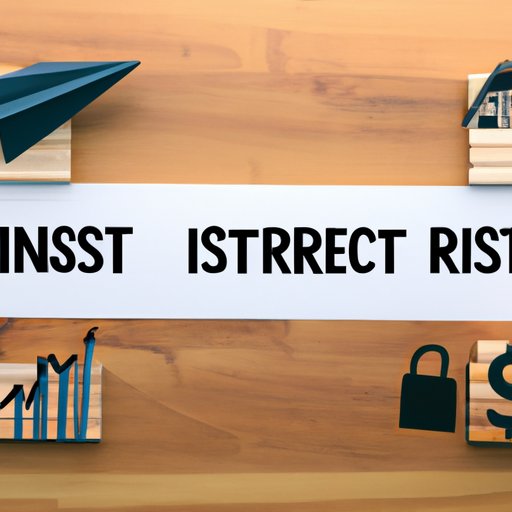Introduction
Investing is a term used to describe the process of putting money into an asset that has the potential to generate income or increase in value over time. Investing can be a great way to grow your wealth and secure your financial future. But before you start investing, it’s important to understand the different types of investments and the risks involved.
A Beginner’s Guide to Investing: What is Investing and How Does it Work?
Investing is the practice of using money to buy assets that have the potential to generate income or increase in value over time. There are many different types of investments, such as stocks, bonds, mutual funds, real estate, and more. Each type of investment carries its own set of risks and rewards. It’s important to do your research and understand the risks before investing.
When it comes to investing, there are two main strategies: active investing and passive investing. Active investors take a hands-on approach, researching and selecting individual stocks and actively managing their portfolios. Passive investors, on the other hand, rely on index funds or exchange-traded funds (ETFs) to track broad market indices, such as the S&P 500. Both strategies have their advantages and disadvantages, so it’s important to do your research and find the strategy that works best for you.
The benefits of investing include the potential for growth, income, and diversification. When you invest, you’re essentially putting your money to work, which means that it has the potential to grow over time. Additionally, some investments, such as dividend-paying stocks, provide a regular source of income. And finally, investing can help diversify your portfolio, reducing your risk and helping you achieve your financial goals.

Exploring Different Types of Investments and Their Benefits
There are many different types of investments available, each with their own set of benefits and risks. Here’s a look at some of the most common types of investments and their benefits.
Stocks
Stocks are one of the most popular types of investments and represent ownership in a company. When you purchase a stock, you become a partial owner of the company and are entitled to a portion of the company’s profits. Stocks also have the potential to increase in value, making them a great long-term investment.
Bonds
Bonds are another popular type of investment. When you invest in bonds, you’re essentially lending your money to a company or government entity. In return, the borrower agrees to pay you interest and repay the principal amount at a predetermined date. Bonds are generally considered to be less risky than stocks, but they tend to have lower returns.
Mutual Funds
Mutual funds are investments that pool the money of multiple investors and invest in a variety of securities, such as stocks and bonds. Mutual funds are managed by professional money managers and offer the benefit of diversification, as they typically contain a mix of different types of investments. However, they also come with higher fees and expenses than other types of investments.
The Pros and Cons of Investing in Stocks, Bonds, and Mutual Funds
When it comes to investing, there are both advantages and disadvantages to investing in stocks, bonds, and mutual funds. Here’s a look at some of the pros and cons of each.
Advantages
Stocks offer the potential for capital appreciation, which means that they have the potential to increase in value over time. Bonds provide a steady stream of income in the form of interest payments. And mutual funds offer the benefit of diversification, as they typically contain a mix of different types of investments.
Disadvantages
Stocks are subject to market volatility, meaning that their value can fluctuate quickly and significantly. Bonds are subject to interest rate risk, meaning that if interest rates rise, the value of the bond will decrease. And mutual funds typically come with higher fees and expenses than other types of investments.

The Risks of Investing and How to Minimize Them
Investing involves risk, and it’s important to understand the risks associated with different types of investments. Here’s a look at some of the most common risks and how to minimize them.
Market Risk
Market risk, also known as systematic risk, is the risk that the overall market will decline, resulting in losses for all investors. This risk cannot be eliminated, but it can be minimized by diversifying your investments across different asset classes and sectors.
Interest Rate Risk
Interest rate risk is the risk that interest rates will change, resulting in a decrease in the value of bonds. To minimize this risk, you should invest in short-term bonds rather than long-term bonds.
Inflation Risk
Inflation risk is the risk that inflation will decrease the purchasing power of your investments. To minimize this risk, you should invest in investments that have the potential to grow faster than inflation, such as stocks and real estate.
Liquidity Risk
Liquidity risk is the risk that you won’t be able to sell your investments quickly enough to meet your needs. To minimize this risk, you should invest in liquid investments, such as stocks and mutual funds.
Tips for Minimizing Risk
To minimize risk, it’s important to diversify your investments across different asset classes and sectors. Additionally, you should regularly review your portfolio to make sure it’s properly diversified and aligned with your goals. Finally, it’s important to have an exit plan in place so that you know when to sell your investments.
Strategies for Building a Solid Investment Portfolio
Building a solid investment portfolio requires a combination of diversification, regular rebalancing, and tax-advantaged investments. Here’s a look at some strategies for building a solid portfolio.
Diversify Your Portfolio
Diversification is key to reducing risk and maximizing returns. You should diversify your portfolio across different asset classes, such as stocks, bonds, and real estate, and across different sectors, such as technology, energy, and healthcare.
Rebalance Regularly
Your portfolio should be regularly rebalanced to ensure that it remains aligned with your goals and risk tolerance. Rebalancing should be done at least once a year, or whenever your portfolio gets out of balance.
Have an Exit Plan
It’s important to have an exit plan in place before you invest. This will help you know when to sell your investments and take profits or cut losses.
Utilize Tax Advantages
Many investments offer tax advantages, such as deductions, credits, and capital gains tax breaks. It’s important to understand the tax implications of your investments and take advantage of any tax benefits available.
Conclusion
Investing can be a great way to grow your wealth and secure your financial future. But it’s important to understand the different types of investments and the risks involved. It’s also important to develop a plan and follow strategies, such as diversification and rebalancing, to build a solid portfolio. With the right knowledge and strategies, you can be well on your way to achieving your financial goals.
(Note: Is this article not meeting your expectations? Do you have knowledge or insights to share? Unlock new opportunities and expand your reach by joining our authors team. Click Registration to join us and share your expertise with our readers.)
